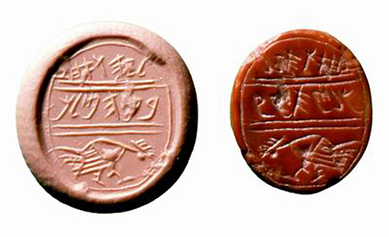“Set me as a seal upon your heart, as a seal upon your arm!” (Song 8:6). How should we understand this erotic imperative, addressed by the female voice of the Song of Songs to her beloved, in view of what we know about ancient seals and what they meant to the people who used them?
In ancient Israel and Judah, as elsewhere in the Near East, a seal (Hebrew, khotam) was used to secure legally binding documents such as contracts or official letters (see 1Kgs 21:8). The author of Song 8:6 certainly had a stamp-seal in mind. This tiny object was roughly the size of a fingertip and usually made of precious or common stone (more rarely, of composite materials or bone). A stamp-seal generally had an oval-shaped base engraved with a figurative design or an inscription. The stamp-seal’s upper side, or back, was often worked figuratively (for example, in the shape of a scarab). Hundreds of examples have been found in the land of Israel.
By comparing herself to a seal, the female narrator shows that she wishes to be both precious property (Sir 17:22) and a personal belonging, since the use of a seal was legally binding (compare Gen 38:18ff.). Beyond its legal implications, a seal was an amulet believed to protect its owner in a peculiar way, attracting positive forces of blessing and repelling evil forces. The narrator thus asks her lover to consider her as his personal property, assuring him of her love’s protective power. (Contrast the opposite move, when Yahweh rejects King Jehoiachin: even if the king were his seal, Yahweh would strip him off his finger and throw him away [Jer 22:24]. The reverse image is applied to Zerubbabel in Hag 2:23 [compare Sir 49:11].)
In Song 8:6, the narrator invites her beloved to put her as a seal on his heart and forearm. But this is not where an ancient Judahite seal-owner would have placed a seal—they were usually worn as necklaces on the chest or breast, or more rarely as rings on the fingers. The specific references to the beloved’s heart (the seat of his will and intelligence) and his arm (representing strength) imply that the narrator hopes to achieve a binding impact upon her lover’s thoughts and decisions, as well as upon his actions. In the same way that she will completely become his personal possession, his thoughts and actions will be totally guided by her protective presence. The verse thus expresses a claim to the couple’s reciprocal exclusivity (compare Deut 11:18).
How, then, does this connect to the second half of the verse, “For love is strong as death, passion fierce as the grave. Its flashes are flashes of fire, a raging flame”? One option, implied by many modern translations, is that the narrator’s love is meant to accompany her beloved right to the grave. Commentators favoring this explanation sometimes refer to the ancient custom of burying seals with dead bodies. But why would the narrator be thinking of her lover’s death at this point in their encounter and attraction? Another explanation considers Song 8:6 as a climax in the quasi-dramatic literary development of Canticles as a whole. Torn between her feelings for her lover and the advances of King Solomon (assuming that Canticles implies some tension between these two male protagonists), the narrator offers herself to her lover as a powerful protective amulet—a seal.


